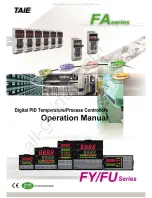
www.supportme.net
4-22 Input / Output
MN1929
4.7.2 CAN wiring
A very low error bit rate over CAN can only be achieved with a suitable wiring scheme, so the
following points should be observed:
H
The two-wire data bus line may be routed parallel, twisted and/or shielded, depending on
EMC requirements. Baldor recommend a twisted pair cable with the shield/screen
connected to the connector backshell, in order to reduce RF emissions and provide
immunity to conducted interference.
H
The bus must be terminated at both ends only (not at intermediate
points) with resistors of a nominal value of 120
Ω
. This is to reduce
reflections of the electrical signals on the bus, which helps a node to
interpret the bus voltage levels correctly. If the NextMove ST is at the
end of the network then ensure that jumper JP1, located just behind
the status display, is in position. This will connect an internal
terminating resistor.
H
All cables and connectors should have a nominal impedance of 120
Ω
.
Cables should have a length related resistance of 70m
Ω
/m and a
nominal line delay of 5ns/m. A range of suitable CAN cables are available from Baldor, with
catalog numbers beginning CBL004-5... .
H
The maximum bus length depends on the bit-timing
configuration (baud rate). The table opposite shows
the approximate maximum bus length (worst-case),
assuming 5ns/m propagation delay and a total
effective device internal in-out delay of 210ns at
1Mbit/s, 300ns at 500 - 250Kbit/s, 450ns at 125Kbit/s
and 1.5ms at 50 - 10Kbit/s.
(1)
CAN baud rate not supported on Baldor CAN.
(2)
For bus lengths greater than about 1000m,
bridge or repeater devices may be needed.
H
The compromise between bus length and CAN baud rate must be determined for each
application. The CAN baud rate can be set using the
BUSBAUD
keyword. It is essential
that all nodes on the network are configured to run at the same baud rate.
H
The wiring topology of a CAN network should be as close as possible to a single line/bus
structure. However, stub lines are allowed provided they are kept to a minimum (<0.3m at
1Mbit/s).
H
The 0V connection of all of the nodes on the network must be tied together through the
CAN cabling. This ensures that the CAN signal levels transmitted by NextMove ST or
CAN peripheral devices are within the common mode range of the receiver circuitry of
other nodes on the network.
4.7.2.1 Opto-isolation
On the NextMove ST, the CAN channel is opto-isolated. A voltage in the range 12-24V must
be applied to pin 5 of the CAN connector. From this supply, an internal voltage regulator
provides the 5V at 100mA required for the isolated CAN circuit. CAN cables supplied by
Baldor are ‘category 5’ and have a maximum current rating of 1A, so the maximum number of
NextMove ST units that may be used on one network is limited to ten. Practical operation of
the CAN channel is limited to 500Kbit/s owing to the propagation delay of the opto-isolators.
JP1
CAN
Maximum
Baud Rate
Bus Length
1Mbit/s
25m
500Kbit/s
100m
250Kbit/s
250m
125Kbit/s
500m
100Kbit/s
(1)
600m
50Kbit/s
1000m
20Kbit/s
2500m
(2)
10Kbit/s
5000m
(2)
Summary of Contents for NextMove ST
Page 1: ...NextMove ST Motion Controller MOTION CONTROL Installation Manual 1 04 MN1929...
Page 2: ......
Page 6: ...iv Contents MN1929...
Page 16: ...www supportme net 3 4 Basic Installation MN1929...
Page 62: ...www supportme net 6 8 Troubleshooting MN1929...
Page 70: ...Comments MN1929 Thank you for taking the time to help us...
Page 71: ......
















































